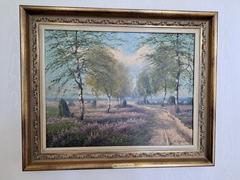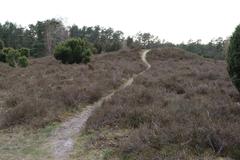
Rischmannshof Heath Museum: Visiting Hours, Tickets, and Historical Significance in Walsrode, Germany
Date: 04/07/2025
Introduction
Nestled in the picturesque Lüneburg Heath region of Lower Saxony, Germany, the Rischmannshof Heath Museum (Heidemuseum Rischmannshof) offers visitors a remarkable journey into the rural heritage and culture of northern Germany. As one of the country’s oldest open-air museums—founded in 1912—it preserves, exhibits, and animates the everyday life, architecture, and customs of the region from the 17th to 19th centuries. The museum is renowned for its authentic farmstead, period buildings, and thematic exhibitions dedicated to notable regional personalities. This guide provides detailed information on the museum’s history, site layout, exhibitions, visiting hours, ticketing, accessibility, and practical tips, ensuring you can make the most of your visit to Walsrode and the surrounding Lüneburg Heath.
For the latest updates, planning resources, and visitor information, consult the official Rischmannshof Heath Museum website and comprehensive guides such as Archaeology Travel’s Lower Saxony resource.
Table of Contents
- Overview and Historical Background
- Architectural and Ethnographic Highlights
- Museum Grounds and Site Layout
- Permanent Exhibitions and Thematic Rooms
- Visiting Hours, Tickets, and Accessibility
- Travel Tips and Nearby Attractions
- Frequently Asked Questions (FAQ)
- Practical Visitor Tips
- Conclusion & Further Resources
Overview and Historical Background
Founded in 1912, the Rischmannshof Heath Museum was established in response to growing concerns over the loss of rural traditions during rapid industrialization. The museum pioneered the preservation of vernacular architecture and intangible cultural heritage in Germany, beginning with the relocation of a traditional smokehouse. Over the years, its collection expanded to include a range of historic buildings—each carefully dismantled, transported, and reconstructed on site to maintain architectural integrity and authenticity (Archaeology Travel).
The museum not only conserves physical structures but also preserves the intangible customs, crafts, and stories that have shaped the Lüneburg Heath’s community identity.
Architectural and Ethnographic Highlights
Main Farmstead (Fachhallenhaus)
The museum’s centerpiece is the impressive Fachhallenhaus, a timber-framed hall house originally built in 1798 in Hartem near Fallingbostel. This Low German house typifies regional construction, combining living quarters, livestock bays, and storage under a single thatched roof. The painstaking reconstruction showcases distinctive architectural features such as the open kitchen (Flett), communal living rooms (Dönzen), and functional stalls—all furnished with authentic period pieces that bring rural life vividly to life (wiki-gateway.eudic.net).
Outbuildings and Historic Structures
Surrounding the main house, several restored buildings illustrate the breadth of rural livelihoods:
- Heuerlinghaus (Hireling’s House): Dating from the late 18th century (originally from Fulde), this modest dwelling highlights the lives of agricultural laborers.
- Treppenspeicher (Storage Barn): The oldest structure (from 1669, Oberndorfmark), raised on posts to protect grain and valuables.
- Backhaus (Bakehouse): An 18th-century wood-fired bakehouse, sometimes used for live demonstrations and baking days.
- Bienenzaun (Apiary): Characteristic Lüneburg Heath beehives (skeps) within a protective fence, reflecting the economic importance of beekeeping.
- Barn and Workshop (1842): Displays agricultural implements and rural crafts, emphasizing the self-sufficiency of farmsteads.
Museum Branch: Klein Eilstorf Village School
An annex in the former Klein Eilstorf village school (built in 1900) explores early 20th-century rural education and hosts special exhibitions (wiki-gateway.eudic.net).
Permanent Exhibitions and Thematic Rooms
- Hans Brüggemann Exhibition: Dedicated to the renowned regional sculptor and woodcarver, illuminating his artistic influence on local identity.
- Hermann Löns Room: Honors the celebrated poet and author, displaying original possessions, first editions, and manuscripts, which highlight the literary and natural history of the Heath (Wikipedia).
- Walsrode City History: Documents, artifacts, and photographs tracing the development of the town and region.
- Rural Life and Craftsmanship: Exhibits of tools, textiles, costumes, and domestic items illustrate everyday work and customs from past centuries.
- Seasonal and Special Exhibitions: The museum regularly organizes temporary exhibitions and events—such as traditional baking days, craft workshops, and harvest festivals—to engage visitors with hands-on experiences.
Visiting Hours, Tickets, and Accessibility
Opening Hours
- April to October: Tuesday to Sunday, 10:00 AM – 5:00 PM
- November to March: Saturday and Sunday, 11:00 AM – 4:00 PM
- Closed Mondays (except on public holidays)
Hours may change for holidays or special events. Always check the official museum site before your visit.
Ticket Prices
- Adults: €6.00–€7.00
- Reduced (students, seniors): €4.00
- Children under 6: Free
- Family Ticket: €15.00 (2 adults + up to 3 children)
- Groups (10+): €5.00 per person
Tickets can be purchased at the entrance or online. Guided tours in German are regularly available; English tours may be arranged with advance notice (official museum website).
Accessibility
- Most pathways are wheelchair accessible; accessible restrooms available.
- Assistance dogs are permitted; for other pets, please inquire in advance.
- Some historic buildings have steps or uneven floors—contact the museum for specific accessibility questions.
Facilities
- Free parking on-site.
- Café, picnic areas, and a museum shop with local crafts and souvenirs.
- Restrooms and family-friendly amenities.
Travel Tips and Nearby Attractions
The museum is located at Hermann-Löns-Straße 8, Walsrode, on the edge of the Eckernworth forest. Easily accessible by car (A7, A27), bicycle, or public transport (bus routes from Walsrode train station). The area offers a range of accommodation and dining options.
Nearby attractions include:
- Weltvogelpark Walsrode: The world’s largest bird park.
- Walsrode Abbey: A historic convent with beautiful gardens.
- Eckernworth Forest: Ideal for hiking and nature walks.
- German Half-Timbered House Route: For those interested in regional architecture.
More information: Lüneburg Heath Nature Park, Walsrode Town Official Site
Frequently Asked Questions (FAQ)
Q: What are the current opening hours?
A: April to October, Tuesday–Sunday, 10:00 AM–5:00 PM; November to March, weekends only. Always check the official website for updates.
Q: How much does admission cost?
A: Adults €6–7; reduced rates for students, seniors, and groups; children under 6 free; family tickets available.
Q: Are guided tours available?
A: Yes, in German regularly; English tours upon request with advance notice.
Q: Is the museum accessible for disabled visitors?
A: Most of the site is accessible; some historic structures pose challenges. Contact the museum for detailed accessibility information.
Q: Can I take photos?
A: Photography is permitted without flash inside the exhibitions.
Practical Visitor Tips
- Best Time to Visit: April–September for full outdoor experience and event days.
- What to Bring: Comfortable shoes, weather-appropriate clothing, and a camera.
- Families and Groups: Educational programs and workshops are available for children and school groups.
- Plan Ahead: Check the museum’s calendar for special events, demonstrations, and themed days.
- Download the Audiala App: For interactive maps, audio guides, and up-to-date information (audiala.com).
Conclusion
The Rischmannshof Heath Museum is a treasure trove of rural German heritage, offering a deeply engaging and authentic experience for visitors of all ages. Its meticulously restored farmstead, thematic exhibitions, and immersive events make it a cultural highlight of the Lüneburg Heath and Walsrode region. To maximize your trip, plan ahead using the museum’s official resources, participate in seasonal activities, and explore the wider attractions of Walsrode and Lower Saxony.
For further information, ticketing, and updates, visit the official museum website and consult reputable travel guides such as Archaeology Travel.
References and Further Reading
- Rischmannshof Heath Museum Walsrode: Visiting Hours, Tickets, and Historical Insights (Archaeology Travel)
- Rischmannshof Heath Museum Visiting Hours, Tickets, and Guide to Walsrode Historical Sites (Wiki-Gateway)
- Visiting Heidemuseum Rischmannshof: Hours, Tickets, and Historical Insights in Walsrode (Whichmuseum)
- Visiting the Rischmannshof Heath Museum in Walsrode: Hours, Tickets, and Insider Tips (Lüneburger Heide Tourism)





